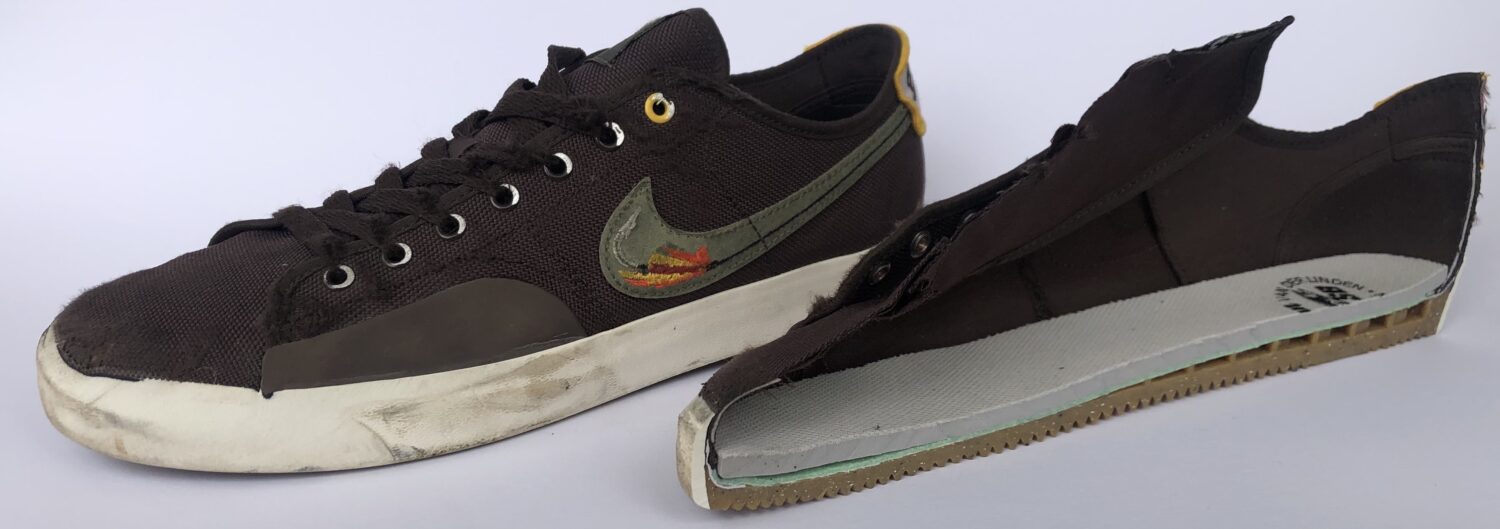Since its introduction to the skate world in 2005 with Lance Mountain pushing the model, the Nike SB Blazer has since become a staple silhouette in the Nike SB product line. It’s gone through various adaptations over the years, with the GT Blazer, collaborations with Frog Skateboards and Isle, and low, mid and high offerings, but it has always remained one of the most classic and noticeable skate shoes in the market. Earlier this year, Nike released an updated Blazer model called the Nike SB BLZR Court, that features a more slim retro look with added skate durability components. Antihero’s Daan Van Der Linden also backed this model release with special DVDL Blazer Court, bringing awareness to the new silhouette and also trust in the shoe’s performance. What originally started as a basketball shoe in the 70’s has now become one of the skate shoes in the market that boast exceptional board feel. Our team has been skating blazers on and off for the past 16 years, and were extremely hyped on getting a pair of the Blazer Courts to test out. Read on below to see how they performed in our 10 hour weartest.
The Nike SB BLZR Court fits true to size.
The Nike SB BLZR Court features design elements that are proven to increase the durability of a shoe but also elements that usually reduce the durability. First of all, the dominant reinforcement piece that stretches from the midfoot to the forefoot section is a typical Ollie-pad and is a tried and true tactic that helps to increase the durability. However, using canvas as a choice for the upper material, is usually a risk when it comes to the durability. The canvas showed signs of wear in the toe area (kickflip-zone) and at the stitching area connecting the sidewall element with the toe piece. The signs of wear are noticeable but not severe, especially since there is another toe reinforcement layer under the canvas. Lastly, durability of a shoe is highly dependent on the outsole. After our weartest, the side areas of the outsole helped to protect the toe area and the durability was really good. All in all, the BLZR Court has an overall above average durability with the most wear concentrated within the toe area (kickflip-zone).
The cushioning of the BLZR Court was ok; the insole is thin and minimal, which sacrificed cushioning in exchange for boardfeel. This was especially the case in the first third toe area, where the sole was the thinnest. In the second third medial area, the cushioning got a bit thicker but not by much; the impact from 5-8 stairs was still fairly absorbed by the insole. The area with the most amount of cushioning was the heel area, where the midsole had a honey comb construction that helped absorb and disperse the impact from landings evenly. In the end, it was clear that the focus of the BLZR Court was to offer a minimally padded shoe that felt great on the feet and had excellent boardfeel.
The shape and silhouette of the BLZR Court was refreshing. A canvas model without many inner supporting elements tends to look out of shape, but once we tried them on foot, the flexible upper material and the narrow upper patterns hug the foot and creates its tailored shape. The shoe is designed to have a clean cut from heel to toe. The model runs parallel from the heel over the midfoot section and starts narrowing in the toe area to end in a nice round shape.
As a vulcanized model, the BLZR Court has a heavy emphasis on boardfeel. Although cushioning is important, Nike SB made sure to not over do the shoe with cushioning elements in order to retain the original boardfeel of a Blazer model, if not making it better. The shoe has a thin sole and its simplicity helps to create enough flexibility so that the feet feel extremely close to the foot. As for grip, the shoe has a traditional outsole thread pattern which proved not only to have excellent grip but also showed good durability. All in all, boardfeel and grip of the BLZR Court was brilliant.
The Nike SB Blazer has partly redefined the standard with regards to the balance between comfort and stability in a modern skate shoe, so it was interesting to see how the BLZR Court and it’s updated features would perform. The main influencers of comfort are weight, breathability and the inner construction. The BLZR Court is extremely lightweight due to its simplicity; both the canvas upper material and the stripped down padding make it super light. In addition, the simple elements of the shoe ensure a basic inner construction which reduces the risk of pressure points. Breathability was average, no major advantages or disadvantages were noticeable. The stability of the shoe was fair; the model wasn’t designed to be exceptional in stability, but rather focused more on the slim shape and excellent boardfeel and grip. Nevertheless, the lack of padding and the canvas materials are significantly reducing the stability, but the slim pattern creates snug foot feeling which in turn, creates a stable feeling. It was noticeable that some elements limited good stability and some elements increased the stability, so overall, we rate the overall stability as average.
The BLZR Court is a very simplistic and comfortable model that doesn’t disappoint in its exceptional boardfeel and grip. The durability showed good performance, especially for a canvas model. With that said, the stability and cushioning are missing some points but it is important to mention that these elements were not the intended focus of the shoe. The legend of the BLZR continues on!

